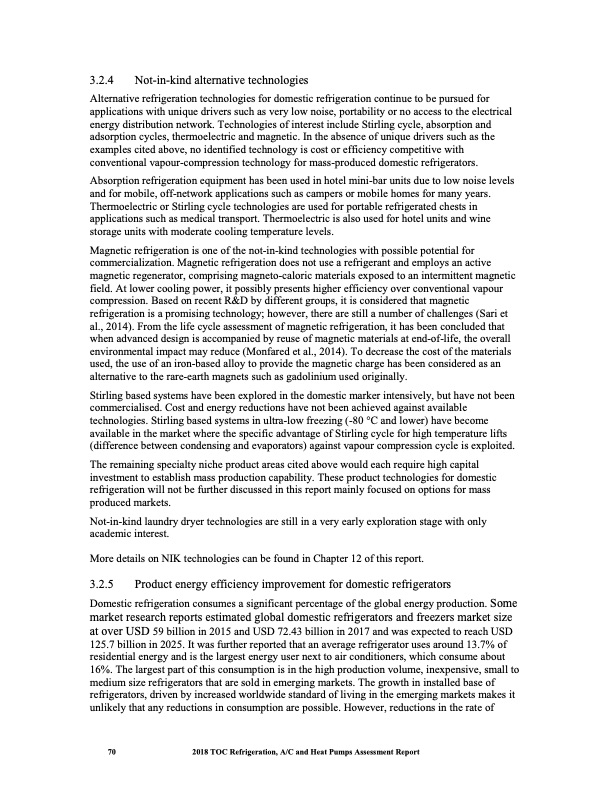
PDF Publication Title:
Text from PDF Page: 083
3.2.4 Not-in-kind alternative technologies Alternative refrigeration technologies for domestic refrigeration continue to be pursued for applications with unique drivers such as very low noise, portability or no access to the electrical energy distribution network. Technologies of interest include Stirling cycle, absorption and adsorption cycles, thermoelectric and magnetic. In the absence of unique drivers such as the examples cited above, no identified technology is cost or efficiency competitive with conventional vapour-compression technology for mass-produced domestic refrigerators. Absorption refrigeration equipment has been used in hotel mini-bar units due to low noise levels and for mobile, off-network applications such as campers or mobile homes for many years. Thermoelectric or Stirling cycle technologies are used for portable refrigerated chests in applications such as medical transport. Thermoelectric is also used for hotel units and wine storage units with moderate cooling temperature levels. Magnetic refrigeration is one of the not-in-kind technologies with possible potential for commercialization. Magnetic refrigeration does not use a refrigerant and employs an active magnetic regenerator, comprising magneto-caloric materials exposed to an intermittent magnetic field. At lower cooling power, it possibly presents higher efficiency over conventional vapour compression. Based on recent R&D by different groups, it is considered that magnetic refrigeration is a promising technology; however, there are still a number of challenges (Sari et al., 2014). From the life cycle assessment of magnetic refrigeration, it has been concluded that when advanced design is accompanied by reuse of magnetic materials at end-of-life, the overall environmental impact may reduce (Monfared et al., 2014). To decrease the cost of the materials used, the use of an iron-based alloy to provide the magnetic charge has been considered as an alternative to the rare-earth magnets such as gadolinium used originally. Stirling based systems have been explored in the domestic marker intensively, but have not been commercialised. Cost and energy reductions have not been achieved against available technologies. Stirling based systems in ultra-low freezing (-80 °C and lower) have become available in the market where the specific advantage of Stirling cycle for high temperature lifts (difference between condensing and evaporators) against vapour compression cycle is exploited. The remaining specialty niche product areas cited above would each require high capital investment to establish mass production capability. These product technologies for domestic refrigeration will not be further discussed in this report mainly focused on options for mass produced markets. Not-in-kind laundry dryer technologies are still in a very early exploration stage with only academic interest. More details on NIK technologies can be found in Chapter 12 of this report. 3.2.5 Product energy efficiency improvement for domestic refrigerators Domestic refrigeration consumes a significant percentage of the global energy production. Some market research reports estimated global domestic refrigerators and freezers market size at over USD 59 billion in 2015 and USD 72.43 billion in 2017 and was expected to reach USD 125.7 billion in 2025. It was further reported that an average refrigerator uses around 13.7% of residential energy and is the largest energy user next to air conditioners, which consume about 16%. The largest part of this consumption is in the high production volume, inexpensive, small to medium size refrigerators that are sold in emerging markets. The growth in installed base of refrigerators, driven by increased worldwide standard of living in the emerging markets makes it unlikely that any reductions in consumption are possible. However, reductions in the rate of 70 2018 TOC Refrigeration, A/C and Heat Pumps Assessment ReportPDF Image | Heat Pumps Technical Options

PDF Search Title:
Heat Pumps Technical OptionsOriginal File Name Searched:
RTOC-assessment-report-2018_0.pdfDIY PDF Search: Google It | Yahoo | Bing
CO2 Organic Rankine Cycle Experimenter Platform The supercritical CO2 phase change system is both a heat pump and organic rankine cycle which can be used for those purposes and as a supercritical extractor for advanced subcritical and supercritical extraction technology. Uses include producing nanoparticles, precious metal CO2 extraction, lithium battery recycling, and other applications... More Info
Heat Pumps CO2 ORC Heat Pump System Platform More Info
| CONTACT TEL: 608-238-6001 Email: greg@infinityturbine.com | RSS | AMP |